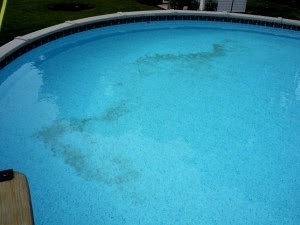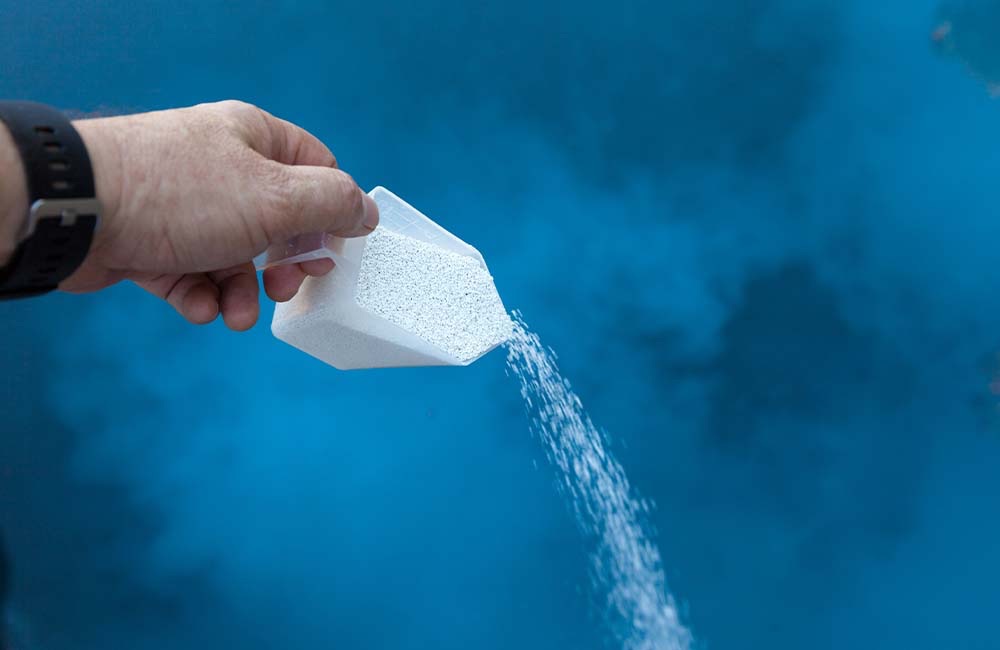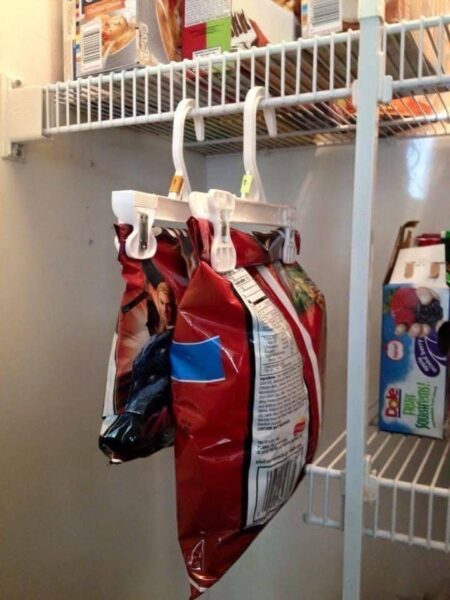
Owning a swimming pool is a fantastic way to enjoy the warm weather, stay active, and entertain friends and family. However, maintaining a pool requires regular attention to ensure the water stays clean and safe for swimming. Various symptoms can indicate underlying issues, from slimy pool walls to cloudy water, and each problem has a specific solution.
In this article, we’ll explore common swimming pool symptoms, their causes, and detailed solutions to address each one. Whether you’re dealing with slick pool walls, green water, or a strong chlorine smell, we’ve got you covered with expert tips to keep your pool in perfect condition. Let’s dive in and tackle these pool problems head-on!
Slimy and Slick Pool Walls and Floor
Symptom: Pool walls and floor feel slimy and slick.
Cause: This is often due to the growth of algae or biofilm. Algae can develop quickly in warm, stagnant water, especially if the pool’s chemical balance is off.
Solution:
- Scrub the Walls and Floor: The first step is to scrub the pool walls and floor to remove the slimy layer. Use a pool brush designed for your pool type (vinyl, fiberglass, or concrete) to avoid damaging the surface.
- Shock the Pool: Apply a shock treatment to kill any remaining algae and bacteria. Shocking the pool involves adding a high dose of chlorine to the water to quickly raise the chlorine level and sanitize the pool. Use a product like HTH 52036 Swimming Pool Care Shock Advanced for effective results.
- Use an Algaecide: After shocking the pool, add an algaecide to prevent future algae growth. A non-foaming algaecide like Clorox® Pool&Spa™ Swimming Pool Algaecide is ideal for keeping your pool water clear and algae-free.
- Maintain Proper Water Chemistry: Regularly test your pool water and adjust the chemical levels to maintain a balanced pH and chlorine level. Keeping your pool’s chemical levels stable is crucial for preventing algae growth and maintaining clean water.
- Regular Maintenance: Follow a consistent maintenance routine that includes brushing the pool walls and floor, vacuuming the pool, and cleaning the filter. Use a detailed pool maintenance checklist to stay on top of regular tasks and keep your pool in great condition.
By addressing the root cause of slimy and slick pool walls and following these steps, you can ensure your pool stays clean, safe, and enjoyable for everyone. Regular maintenance and proper chemical balance are key to preventing algae and biofilm from taking hold in your pool.

Cloudy Pool Water
Symptom: Pool water appears cloudy or murky.
Cause: Cloudy pool water can be caused by a variety of factors, including improper chemical balance, poor filtration, or the presence of contaminants such as dirt, debris, or algae.
Solution:
- Test and Balance Water Chemistry: Start by testing the pool water to check the levels of pH, chlorine, alkalinity, and calcium hardness. Use a reliable pool water testing kit for accurate results. Cloudy water often indicates an imbalance, so adjust the chemicals as needed to bring the levels back to their optimal range.
- Shock the Pool: Sometimes, the cloudiness is due to organic contaminants that regular chlorination can’t handle. Performing a shock treatment can clear up the water by breaking down these contaminants. Use a high-quality shock treatment like HTH 52036 Swimming Pool Care Shock Advanced to restore clarity.
- Clean the Pool Filter: A clogged or dirty filter can’t effectively remove particles from the water, leading to cloudiness. Clean or backwash your filter according to the manufacturer’s instructions. If your filter is old or damaged, consider replacing it.
- Improve Circulation: Ensure that your pool pump and filtration system are running efficiently. Poor water circulation can lead to stagnant areas where particles accumulate. Run the pump for at least 8-12 hours a day to maintain proper water flow and filtration.
- Use a Pool Clarifier: If the water remains cloudy after balancing chemicals and cleaning the filter, add a pool clarifier. Clarifiers help bind small particles together so they can be more easily trapped by the filter. Follow the product instructions for best results.
- Regular Maintenance: Keep up with routine maintenance tasks like skimming debris, brushing pool walls, and vacuuming the pool floor. Consistent maintenance helps prevent the buildup of contaminants that can cloud the water. For a comprehensive guide, refer to this pool maintenance checklist.
By following these steps, you can clear up cloudy pool water and prevent it from recurring. Maintaining balanced water chemistry and ensuring efficient filtration are essential for keeping your pool water crystal clear and inviting. Regular monitoring and maintenance will help you identify and address any issues before they become major problems.

Green Pool Water
Symptom: Pool water has turned green.
Cause: Green pool water is typically caused by algae growth. This can happen when chlorine levels are too low, the pH is unbalanced, or the pool has been neglected for a period of time.
Solution:
- Test and Balance Water Chemistry: Start by testing your pool water to check the levels of pH, chlorine, and alkalinity. Adjust these levels as needed to bring them within the proper range. Balanced water chemistry is crucial for effective algae treatment.
- Shock the Pool: Perform a shock treatment to kill the algae. This involves adding a large dose of chlorine to the pool. For best results, use a product like HTH 52036 Swimming Pool Care Shock Advanced. Follow the package instructions for the correct dosage based on your pool size.
- Brush and Vacuum the Pool: After shocking the pool, brush the walls, floor, and any other surfaces to remove the dead algae. Use a pool vacuum to clean up the debris. This step helps prevent the algae from settling back into the water.
- Add an Algaecide: Once the initial algae bloom has been treated, add an algaecide to the pool to prevent future growth. A non-foaming algaecide like Clorox® Pool&Spa™ Swimming Pool Algaecide is effective for ongoing algae control.
- Clean the Filter: A clean filter is essential for removing algae and other contaminants from the water. Clean or backwash your filter to ensure it is functioning properly. If your filter is old or damaged, consider replacing it to improve filtration efficiency.
- Improve Circulation: Ensure your pool’s circulation system is working efficiently. Run the pump for at least 8-12 hours a day to maintain proper water flow and filtration. Good circulation helps distribute chemicals evenly and prevents algae from settling.
- Regular Maintenance: Follow a consistent maintenance routine to prevent algae from returning. This includes regular testing and balancing of water chemistry, brushing and vacuuming the pool, and cleaning the filter. A detailed pool maintenance checklist can help you stay on track with these tasks.
By addressing the root causes of green pool water and following these steps, you can restore your pool to its clear, inviting state. Regular maintenance and proper chemical balance are key to preventing algae growth and keeping your pool water sparkling clean.
Pool shock is a MUST! Get yours from Amazon with our link here!
Strong Chlorine Smell
Symptom: There is a strong chlorine smell around the pool area.
Cause: A strong chlorine smell is often caused by chloramines, which form when chlorine binds with contaminants like sweat, body oils, and urine. This can indicate that the pool needs more chlorine, not less, to break down these compounds.
Solution:
- Shock the Pool: The first step to eliminating the strong chlorine smell is to shock the pool. Shocking the pool involves adding a large dose of chlorine to break down chloramines and other organic contaminants. Use a high-quality shock treatment like HTH 52036 Swimming Pool Care Shock Advanced to effectively sanitize the water.
- Ensure Proper Ventilation: If you have an indoor pool, make sure the area is well-ventilated. Poor ventilation can trap chloramines and make the smell more noticeable. Open windows and doors or use fans to improve air circulation around the pool.
- Balance Water Chemistry: Regularly test and balance the pool’s water chemistry, including pH, chlorine, and alkalinity levels. Proper chemical balance helps maintain chlorine’s effectiveness and reduces the formation of chloramines.
- Clean the Pool: Regularly clean the pool to remove debris and organic matter that contribute to chloramine formation. This includes skimming the surface, brushing the walls and floor, and vacuuming the pool.
- Use an Enzyme-Based Pool Cleaner: Enzyme-based cleaners can help break down organic contaminants, reducing the burden on chlorine. These cleaners work alongside chlorine to keep the water clear and minimize chloramine buildup.
- Encourage Showering Before Swimming: Encourage swimmers to shower before entering the pool to rinse off sweat, body oils, and other contaminants. This simple step can significantly reduce the formation of chloramines and the associated chlorine smell.
- Regular Maintenance: Follow a regular maintenance schedule to keep your pool in top condition. This includes weekly testing of water chemistry, monthly filter cleaning, and periodic shocking. A comprehensive pool maintenance checklist can help ensure you stay on top of these tasks.
By understanding the cause of the strong chlorine smell and following these solutions, you can ensure a more pleasant swimming experience. Proper maintenance, regular cleaning, and balanced water chemistry are essential for keeping chloramines under control and maintaining a clean, fresh pool environment.

Stains on Pool Walls and Floor
Symptom: Visible stains on the pool’s walls and floor.
Cause: Stains in a swimming pool can be caused by metals (such as iron, copper, or manganese), organic materials (like leaves or algae), or an imbalance in the pool’s water chemistry.
Solution:
- Identify the Type of Stain:
- Metallic Stains: Often appear as reddish-brown (iron), bluish-green (copper), or black (manganese).
- Organic Stains: Typically appear as greenish or brownish patches, usually caused by leaves, algae, or other organic debris.
- Mineral Stains: Result from high levels of calcium or other minerals, appearing as white, crusty deposits.
- Test and Balance Water Chemistry: Start by testing your pool’s water chemistry and adjusting the levels as needed. Maintaining balanced water chemistry helps prevent and reduce staining. Pay particular attention to pH, alkalinity, and calcium hardness levels.
- Use a Stain Remover:
- For metallic stains, use a metal sequestrant or stain remover specifically designed for pools. Follow the product instructions for the best results.
- For organic stains, shock the pool and use an enzyme-based cleaner to break down the organic matter. Additionally, regularly brushing and vacuuming the pool helps remove these stains.
- Brush and Clean the Affected Areas: Use a pool brush to scrub the stained areas thoroughly. For tough stains, you may need to use a pumice stone or a specialized stain-removal tool.
- Shock the Pool: Apply a shock treatment to the pool to help remove organic stains and sanitize the water. A product like HTH 52036 Swimming Pool Care Shock Advanced is effective for this purpose.
- Use a Metal Sequestrant: If your pool water has a high metal content, adding a metal sequestrant can help prevent and remove metal stains. This product binds with metals in the water, preventing them from depositing on pool surfaces.
- Prevent Future Stains:
- Regularly test and balance your pool water to maintain proper chemical levels.
- Clean your pool filter regularly to ensure it’s functioning effectively.
- Remove leaves and other organic debris promptly to prevent organic stains.
- Use a pool cover to protect the water from debris and contaminants when the pool is not in use.
- Consult a Professional: If stains persist despite your efforts, consider consulting a pool maintenance professional. They can provide specialized treatments and advice for stubborn or severe stains.
For more detailed guidance on pool maintenance and preventing common issues, refer to this comprehensive pool maintenance checklist. By following these steps, you can effectively remove stains from your pool and maintain a clean, inviting swimming environment.

Keeping your pool free of stains requires consistent care and attention. Regular maintenance and proper chemical balance are key to preventing stains and ensuring your pool remains a beautiful and enjoyable space for swimming.
Most problems with your pool water can be prevented and helped with pool shock, luckily you can buy it here on Amazon. We picked a good pack for you to buy!
Algae Growth
Symptom: Visible algae on pool surfaces or in the water.
Cause: Algae can grow in a pool due to poor water circulation, low chlorine levels, imbalanced pH, or insufficient maintenance. Algae thrive in warm, stagnant water, making regular upkeep crucial.
Solution:
- Brush the Pool Surfaces: Begin by brushing the walls, floor, and any other surfaces to loosen the algae. Use a brush appropriate for your pool type (nylon for vinyl and fiberglass, stainless steel for concrete).
- Shock the Pool: Apply a shock treatment to kill the algae. Shocking the pool involves adding a high dose of chlorine to the water. For effective results, use HTH 52036 Swimming Pool Care Shock Advanced. Follow the package instructions to determine the correct dosage based on your pool size.
- Add an Algaecide: After shocking the pool, use an algaecide to kill any remaining algae and prevent future growth. A non-foaming algaecide like Clorox® Pool&Spa™ Swimming Pool Algaecide is effective in keeping your pool algae-free.
- Vacuum the Pool: After the algae have been killed, vacuum the pool to remove the dead algae and other debris. If you have a manual vacuum, set it to waste to bypass the filter and prevent clogging.
- Clean the Filter: Algae can clog your pool filter, so it’s important to clean or backwash it after treatment. This ensures your filter is working efficiently to keep the water clean.
- Maintain Proper Water Circulation: Ensure that your pool pump and filtration system are running efficiently. Poor circulation can create stagnant areas where algae can thrive. Run the pump for at least 8-12 hours a day to maintain proper water flow and filtration.
- Test and Balance Water Chemistry: Regularly test your pool water to ensure proper chemical balance. Algae thrive in water with low chlorine levels and imbalanced pH. Keeping your water chemistry within the recommended ranges is essential for preventing algae growth. Refer to a detailed pool maintenance checklist for guidance.
- Preventive Measures:
- Use a Pool Cover: Covering your pool when it’s not in use can prevent debris and contaminants from entering the water, reducing the risk of algae growth.
- Shock Regularly: Regularly shocking your pool, even when there are no visible signs of algae, can help maintain clear, clean water.
- Maintain Chlorine Levels: Ensure your chlorine levels are always within the recommended range to prevent algae from taking hold.
- Regular Maintenance: Consistent maintenance is key to preventing algae growth. This includes weekly brushing, vacuuming, testing, and adjusting the water chemistry. For more DIY tips on maintaining your pool and other home projects, check out these DIY home maintenance tips.
By following these steps and maintaining regular pool care, you can effectively control and prevent algae growth, keeping your pool water clear and inviting. Proper water circulation, balanced chemistry, and routine maintenance are essential for a healthy pool environment.

Poor Water Circulation
Symptom: Stagnant areas in the pool or poor water flow.
Cause: Poor water circulation can be caused by clogged filters, blocked skimmers, malfunctioning pumps, or inadequate pool pump run times. Good water circulation is essential for distributing chemicals evenly, filtering out debris, and preventing algae growth.
Solution:
- Clean the Pool Filter: A clogged or dirty filter can significantly reduce water flow. Clean or backwash your filter according to the manufacturer’s instructions. If your filter is old or damaged, consider replacing it to ensure efficient filtration.
- Check and Clean Skimmers: Skimmers can become blocked with leaves, debris, and other contaminants. Regularly check and clean your skimmers to ensure they are free of obstructions and can function properly.
- Inspect the Pump: Ensure that your pool pump is operating correctly. Check for any signs of wear or damage and make sure the pump basket is clean. If your pump is not working efficiently, it might be time for a repair or replacement.
- Adjust Pump Run Times: Ensure that your pool pump is running for at least 8-12 hours a day. This helps maintain proper water circulation and filtration. If you have an automatic timer, set it to run during the day when the pool is in use and the water needs the most circulation.
- Install a Pool Circulator: If you have persistent circulation problems, consider installing a pool circulator. These devices attach to your pool’s return jets and help improve water flow and distribution.
- Regular Brushing and Vacuuming: Regularly brush the walls and floor of your pool to prevent algae and debris buildup. Vacuuming helps remove particles that can clog the filter and impede circulation.
- Maintain Proper Water Levels: Ensure that your pool water level is maintained at the midpoint of the skimmer opening. Low water levels can cause the pump to suck in air, reducing its efficiency and potentially causing damage.
- Check for Leaks: Inspect your pool system for leaks. Leaks can reduce water pressure and circulation. Common areas to check include the pump, filter, and plumbing connections.
- Preventive Maintenance: Follow a regular maintenance routine to keep your pool equipment in top condition. This includes weekly inspections, cleaning, and adjustments as needed. A detailed pool maintenance checklist can help you stay on top of these tasks.
By ensuring proper water circulation, you can keep your pool clean, clear, and free from algae and debris. Regular maintenance and monitoring of your pool equipment are key to maintaining efficient water flow and a healthy swimming environment. For more DIY home maintenance tips and projects, check out this guide on creating soft and serene lighting decor.
Unbalanced Water Chemistry
Symptom: Frequent pH imbalances or inconsistent chlorine levels.
Cause: Unbalanced water chemistry can result from incorrect chemical additions, inadequate testing, or environmental factors such as rain, debris, and heavy pool use. Maintaining balanced water chemistry is essential for ensuring the effectiveness of sanitizers and the overall health of the pool water.
Solution:
- Regular Testing: Test your pool water at least twice a week using a reliable pool water testing kit. Check for pH, chlorine, alkalinity, calcium hardness, and cyanuric acid levels. Keeping a log of your test results can help you track changes and make necessary adjustments.
- Adjust pH Levels:
- Low pH (below 7.2): Add a pH increaser (sodium carbonate or soda ash) to raise the pH level. Follow the product instructions for the correct dosage.
- High pH (above 7.8): Add a pH reducer (muriatic acid or sodium bisulfate) to lower the pH level. Carefully follow the product instructions to avoid overcorrecting.
- Balance Alkalinity: Total alkalinity helps buffer the pH and keeps it stable. The ideal range is 80-120 ppm (parts per million).
- Low Alkalinity: Add an alkalinity increaser (baking soda or sodium bicarbonate) to raise the alkalinity level.
- High Alkalinity: Add a pH reducer (muriatic acid or sodium bisulfate) in small doses, gradually adjusting the levels.
- Maintain Proper Chlorine Levels: Chlorine is essential for sanitizing the pool and keeping it free from harmful bacteria and algae. The ideal chlorine level is 1-3 ppm.
- Regularly add chlorine tablets or granules to maintain the proper level.
- Use a floating chlorine dispenser to help evenly distribute chlorine throughout the pool.
- Calcium Hardness: The ideal range for calcium hardness is 200-400 ppm.
- Low Calcium Hardness: Add a calcium hardness increaser to prevent water from becoming corrosive.
- High Calcium Hardness: Dilute the pool water by partially draining and refilling it with fresh water. Avoid using calcium-based chlorine products.
- Use Stabilizer (Cyanuric Acid): Cyanuric acid helps protect chlorine from being degraded by sunlight. The ideal range is 30-50 ppm.
- Add stabilizer as needed, especially after heavy rains or when refilling the pool.
- Consistent Maintenance: Follow a regular maintenance routine to keep your water chemistry balanced. This includes weekly testing, adjusting chemicals, and performing shock treatments as needed. Use a detailed pool maintenance checklist to stay organized and ensure all tasks are completed.
- Shock the Pool Regularly: Shocking the pool helps to remove contaminants and maintain chlorine levels. Use a quality shock treatment like HTH 52036 Swimming Pool Care Shock Advanced to keep the water clean and clear.
By regularly testing and adjusting your pool’s water chemistry, you can ensure a safe and pleasant swimming environment. Balanced water chemistry not only keeps the pool clean but also extends the life of your pool equipment and surfaces. Consistent maintenance and proper chemical management are key to a well-balanced and healthy pool. For more DIY tips and projects around the home, explore this guide on elevating your outdoor space with a DIY horizontal board fence.

Preventive Maintenance Tips
Proper preventive maintenance is key to keeping your pool in pristine condition and avoiding common problems. By following these tips, you can ensure your pool remains clean, safe, and enjoyable for everyone.
1. Regular Cleaning:
- Skim Debris Daily: Use a skimmer net to remove leaves, bugs, and other debris from the pool surface daily. This prevents debris from sinking to the bottom and affecting water quality.
- Brush and Vacuum Weekly: Brush the pool walls and floor to remove algae and dirt. Vacuum the pool weekly to remove settled debris. Automatic pool cleaners can help make this task easier.
2. Consistent Chemical Testing and Balancing:
- Test Water Frequently: Use a reliable pool testing kit to check pH, chlorine, alkalinity, and other chemical levels at least twice a week.
- Adjust Chemicals as Needed: Add chemicals to maintain balanced water chemistry. Proper chemical balance prevents algae growth, staining, and corrosion.
3. Filter Maintenance:
- Clean or Backwash Filter: Clean or backwash your pool filter according to the manufacturer’s instructions. A clean filter ensures effective filtration and water circulation.
- Inspect and Replace Filters: Regularly inspect your filter for signs of wear or damage. Replace it if necessary to maintain optimal performance.
4. Maintain Proper Water Levels:
- Monitor Water Levels: Keep the water level at the midpoint of the skimmer opening. Low water levels can cause the pump to suck in air, reducing efficiency and potentially causing damage.
- Refill as Needed: Add water to the pool as needed, especially after heavy use or evaporation.
5. Regular Shock Treatments:
- Shock the Pool Weekly: Shocking the pool helps eliminate contaminants and maintain clear water. Use a product like HTH 52036 Swimming Pool Care Shock Advanced for effective results.
6. Use Algaecide Preventatively:
- Add Algaecide Weekly: Adding a non-foaming algaecide like Clorox® Pool&Spa™ Swimming Pool Algaecideweekly can help prevent algae growth and keep the water clear.
7. Inspect Pool Equipment:
- Check Pumps and Heaters: Regularly inspect your pool pump, heater, and other equipment for proper operation. Address any issues promptly to avoid larger problems.
- Clean Pump Basket: Clean the pump basket regularly to ensure proper water flow and prevent clogging.
8. Use a Pool Cover:
- Cover the Pool When Not in Use: A pool cover helps keep debris out, reduces water evaporation, and maintains water temperature. It also prevents algae growth by limiting sunlight exposure.
9. Manage Surrounding Landscaping:
- Trim Overhanging Trees: Trim trees and bushes near the pool to minimize debris falling into the water. Consider landscaping options that reduce the amount of organic material entering the pool.
10. Follow a Maintenance Schedule:
- Create a Checklist: Use a detailed pool maintenance checklist to stay organized and ensure all tasks are completed. Consistent maintenance prevents problems and extends the life of your pool.
By implementing these preventive maintenance tips, you can keep your pool in excellent condition and enjoy a safe, clean swimming environment. Regular care and attention to your pool’s needs will help prevent common issues and ensure that your pool remains a source of fun and relaxation. For more home maintenance tips and DIY projects, explore this guide on non-toxic ways to repel hornets, wasps, and bees.
As an Amazon Associate we earn from qualifying purchases through some links in our articles.



